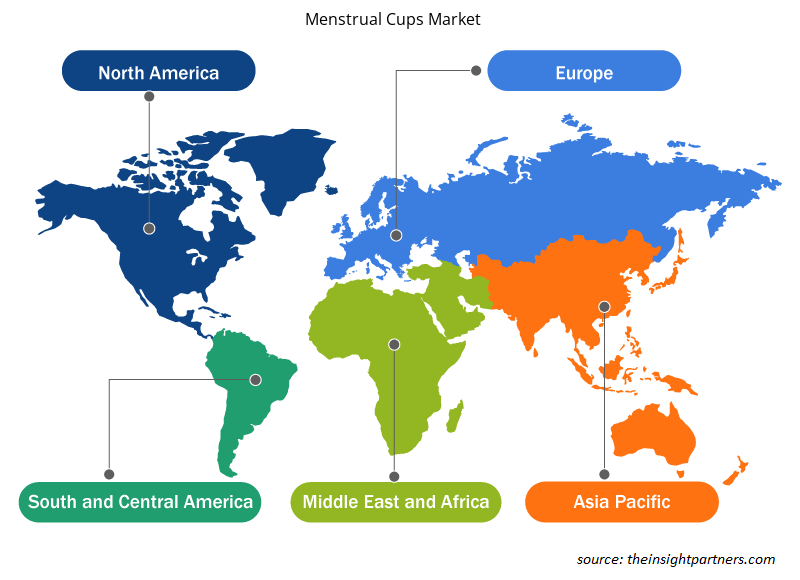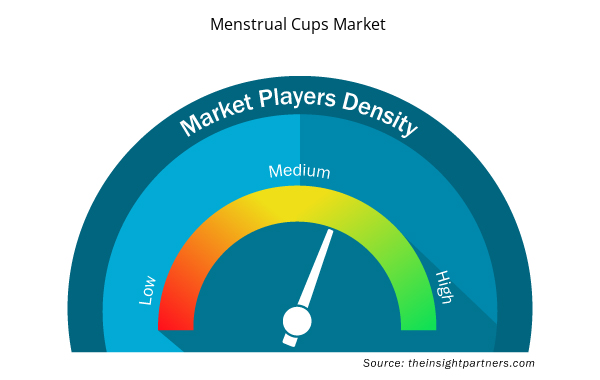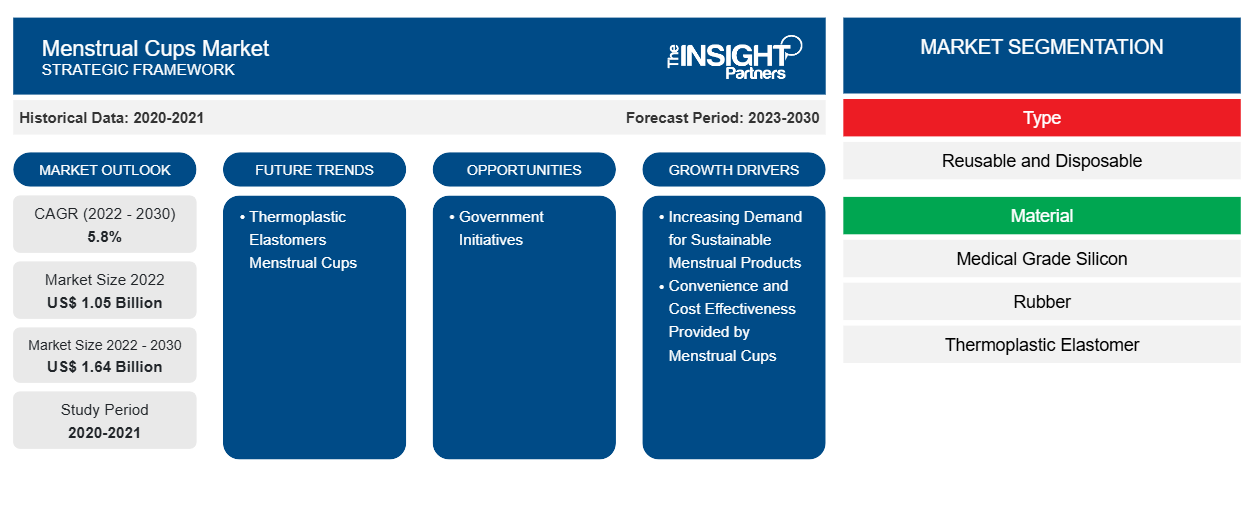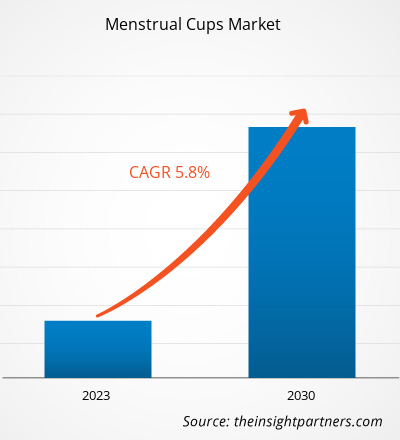[Rapporto di ricerca] Il mercato delle coppette mestruali è stato valutato a 1.050,81 milioni di dollari nel 2022 e si prevede che raggiungerà 1.644,06 milioni di dollari entro il 2030; si stima che registrerà un CAGR del 5,8% dal 2022 al 2030.
Approfondimenti di mercato e opinioni degli analisti:
Le coppette mestruali sono dispositivi riutilizzabili a forma di campana, progettati per l'igiene femminile durante le mestruazioni. Solitamente realizzate in silicone o gomma di grado medico, queste coppette vengono inserite nella vagina per raccogliere il fluido mestruale anziché assorbirlo come i tradizionali tamponi o assorbenti. Creano una tenuta per prevenire perdite e possono essere indossate fino a 12 ore prima di dover essere svuotate, offrendo un'alternativa sostenibile ed economica ai prodotti monouso. Le coppette mestruali stanno guadagnando popolarità per i loro benefici ambientali e per i risparmi sui costi a lungo termine rispetto alle tradizionali opzioni di igiene mestruale.
Fattori di crescita e sfide:
La crescente domanda di prodotti mestruali sostenibili è un fattore trainante primario che spinge il mercato delle coppette mestruali. Negli ultimi anni, c'è stato un cambiamento globale verso la sostenibilità, con i consumatori che sono diventati sempre più consapevoli dell'impatto ambientale dei tradizionali prodotti mestruali monouso. Gli assorbenti e i tamponi tradizionali contribuiscono in modo significativo allo spreco di plastica e la loro produzione comporta il consumo di risorse ed energia. Ogni anno, una donna media getta via quasi 150 chilogrammi di rifiuti non biodegradabili. Solo in India, circa 121 milioni di donne e ragazze usano una media di otto assorbenti monouso e non compostabili al mese, generando 1,021 miliardi di rifiuti di assorbenti al mese, 12,3 miliardi di rifiuti di assorbenti all'anno e 113.000 tonnellate di rifiuti mestruali all'anno. Le coppette mestruali sono emerse come una scelta leader poiché le persone cercano alternative ecologiche grazie alla loro natura riutilizzabile. Questa maggiore consapevolezza ambientale spinge i consumatori a optare per prodotti che riducono al minimo il loro impatto ecologico, aumentando la domanda di coppette mestruali.
La crescente domanda di prodotti mestruali sostenibili è strettamente legata a un movimento più ampio che sostiene la salute e il benessere delle donne. I consumatori stanno dando sempre più priorità a prodotti che non siano solo buoni per l'ambiente, ma anche sicuri e benefici per la loro salute. Le coppette mestruali, solitamente realizzate in silicone di grado medico, gomma o elastomeri termoplastici, sono considerate sicure e igieniche, riducendo il rischio di irritazioni e reazioni allergiche spesso associate ai prodotti tradizionali. L'allineamento delle coppette mestruali con la sostenibilità ambientale e la salute delle donne contribuisce al loro fascino, agendo come motore della loro crescente popolarità.
Personalizza questo report in base alle tue esigenze
Riceverai la personalizzazione gratuita di qualsiasi report, comprese parti di questo report, o analisi a livello nazionale, pacchetto dati Excel, oltre a usufruire di grandi offerte e sconti per start-up e università
- Scopri le principali tendenze di mercato in questo rapporto.Questo campione GRATUITO includerà analisi di dati che spaziano dalle tendenze di mercato alle stime e alle previsioni.
La richiesta di sostenibilità nei prodotti mestruali è stata amplificata da vari gruppi di advocacy, ONG e iniziative governative che mirano a sensibilizzare sull'impatto ambientale delle opzioni monouso. Le campagne che promuovono mestruazioni sostenibili sono state fondamentali per educare il pubblico sui vantaggi delle alternative riutilizzabili come le coppette mestruali. La crescente visibilità e il sostegno di pratiche mestruali sostenibili contribuiscono a un cambiamento positivo negli atteggiamenti dei consumatori, favorendo una maggiore accettazione e adozione delle coppette mestruali.
La domanda di prodotti mestruali sostenibili è alimentata anche da una generazione più giovane di consumatori che dà priorità alle scelte eco-consapevoli. I Millennial e la Generazione Z, in particolare, guidano la domanda di prodotti sostenibili ed etici in vari settori, tra cui la cura della persona. La consapevolezza e le preferenze di questi gruppi demografici influenzano le tendenze del mercato e le coppette mestruali, essendo un'opzione sostenibile e lungimirante, si allineano bene con i loro valori. Man mano che questo gruppo demografico continua a crescere in termini di potere d'acquisto, crescerà anche la domanda di coppette mestruali, rafforzando la loro posizione sul mercato come prodotto mestruale sostenibile leader.
Tuttavia, la percezione e la scarsa consapevolezza dei consumatori rappresentano notevoli limitazioni nel mercato delle coppette mestruali, con un impatto sui tassi di adozione a livello globale. Molte persone rimangono disinformate sui benefici delle coppette mestruali a causa della mancanza di campagne di istruzione e sensibilizzazione complete. La scarsa familiarità con il prodotto e i suoi vantaggi, come il rapporto costo-efficacia, il ridotto impatto ambientale e il tempo di utilizzo prolungato, contribuisce alla riluttanza delle potenziali utilizzatrici a passare dai tradizionali prodotti mestruali. Questa mancanza di conoscenza può portare a idee sbagliate e inibizioni, ostacolando la più ampia accettazione delle coppette mestruali come alternativa pratica e pratica.
L'esitazione nell'uso delle coppette mestruali è spesso radicata in preoccupazioni circa la difficoltà di inserimento e rimozione. Molte consumatrici percepiscono la curva di apprendimento associata all'uso delle coppette mestruali come una barriera, supponendo che richieda un livello di abilità o di comfort che potrebbero non possedere. La mancanza di comprensione circa l'applicazione semplice delle coppette mestruali e i potenziali benefici per la salute contribuisce a questa apprensione. Superare queste nozioni preconcette e idee sbagliate richiede sforzi educativi mirati per evidenziare la facilità d'uso, il comfort e l'impatto ambientale positivo delle coppette mestruali. Affrontando queste preoccupazioni e promuovendo la consapevolezza, il mercato può lavorare per dissipare i miti e incoraggiare una percezione più positiva delle coppette mestruali tra le potenziali utilizzatrici.
Segmentazione e ambito del report:
Il mercato globale delle coppette mestruali è segmentato in base a tipo, materiale, canale di distribuzione e area geografica. In base al tipo, il mercato è categorizzato in riutilizzabile e monouso. In base al materiale, il mercato è categorizzato in silicone di grado medicale, gomma ed elastomero termoplastico. In base al canale di distribuzione, il mercato è categorizzato in supermercati e ipermercati, negozi specializzati, vendita al dettaglio online e altri. In base all'area geografica, il mercato globale delle coppette mestruali è ampiamente segmentato in Nord America, Europa, Asia Pacifico, Medio Oriente e Africa e Sud e Centro America.
Analisi segmentale:
In base al tipo, il mercato delle coppette mestruali è suddiviso in riutilizzabili e monouso. Si prevede che il segmento riutilizzabile registrerà il CAGR più elevato nel periodo 2022-2030. Le coppette mestruali riutilizzabili rappresentano una rivoluzione sostenibile ed economica nell'igiene mestruale. Solitamente realizzate in silicone di grado medico, gomma o elastomeri termoplastici, queste coppette a campana vengono inserite nella vagina per raccogliere il flusso mestruale anziché assorbirlo come i tradizionali tamponi o assorbenti. La flessibilità e la morbidezza del materiale assicurano comfort e facilità d'uso, adattandosi all'anatomia dell'utente. Le coppette mestruali riutilizzabili possono essere indossate fino a 12 ore, offrendo una protezione senza perdite e consentendo all'utente una maggiore flessibilità nella gestione del ciclo mestruale. Uno dei loro vantaggi più significativi è il loro impatto ambientale, poiché possono essere riutilizzate. Le coppette riducono significativamente la quantità di rifiuti mestruali prodotti, contribuendo a una routine di cura mestruale ecologica. Inoltre, il risparmio sui costi a lungo termine e la comodità di non dover acquistare regolarmente prodotti usa e getta rendono le coppette mestruali riutilizzabili una scelta sempre più popolare per le utilizzatrici che cercano alternative sostenibili e pratiche per l'igiene mestruale.
Analisi regionale:
Il mercato delle coppette mestruali è suddiviso in cinque regioni chiave: Nord America, Europa, Asia Pacifico, Sud e Centro America e Medio Oriente e Africa. Il Nord America ha dominato il mercato globale delle coppette mestruali nel 2022, poiché il mercato in questa regione è stato valutato a 395,41 milioni di dollari USA. L'Europa è un secondo importante contributore, detenendo una quota di mercato globale superiore al 30%. Si prevede che l'Asia Pacifico registrerà un CAGR considerevole di oltre il 5% nel periodo 2022-2030. L'aumento della domanda di coppette mestruali nell'Asia Pacifico può essere attribuito a vari fattori, tra cui i crescenti cambiamenti culturali, la crescente consapevolezza e la crescente importanza della salute delle donne. C'è stato un crescente movimento verso la rottura dei tabù che circondano le mestruazioni in molti paesi asiatici.
Impatto della pandemia di COVID-19:
La pandemia di COVID-19 ha inizialmente ostacolato il mercato globale delle coppette mestruali a causa della chiusura delle unità di produzione, della carenza di manodopera, dell'interruzione delle catene di fornitura e dell'instabilità finanziaria. L'interruzione delle operazioni in vari settori a causa del rallentamento economico causato dall'epidemia di COVID-19 ha frenato la fornitura di coppette mestruali. Inoltre, vari negozi sono stati chiusi, il che ha limitato le vendite di coppette mestruali. Tuttavia, le aziende hanno iniziato a guadagnare terreno poiché le limitazioni precedentemente imposte sono state revocate in vari paesi nel 2021. Inoltre, l'implementazione di campagne di vaccinazione COVID-19 da parte dei governi di diversi paesi ha alleviato la situazione, portando a un aumento delle attività commerciali in tutto il mondo. Diversi mercati, incluso il mercato delle coppette mestruali, hanno registrato una crescita dopo l'allentamento dei lockdown e delle restrizioni alla circolazione.
Approfondimenti regionali sul mercato delle coppette mestruali
Le tendenze regionali e i fattori che influenzano il mercato delle coppette mestruali durante il periodo di previsione sono stati ampiamente spiegati dagli analisti di Insight Partners. Questa sezione discute anche i segmenti e la geografia del mercato delle coppette mestruali in Nord America, Europa, Asia Pacifico, Medio Oriente e Africa e America meridionale e centrale.

- Ottieni i dati specifici regionali per il mercato delle coppette mestruali
Ambito del rapporto di mercato sulle coppette mestruali
| Attributo del report | Dettagli |
|---|---|
| Dimensioni del mercato nel 2022 | 1,05 miliardi di dollari USA |
| Dimensioni del mercato entro il 2030 | 1,64 miliardi di dollari USA |
| CAGR globale (2022-2030) | 5,8% |
| Dati storici | 2020-2021 |
| Periodo di previsione | 2023-2030 |
| Segmenti coperti | Per tipo
|
| Regioni e Paesi coperti | America del Nord
|
| Leader di mercato e profili aziendali chiave |
|
Densità dei player del mercato delle coppette mestruali: comprendere il suo impatto sulle dinamiche aziendali
Il mercato delle coppette mestruali sta crescendo rapidamente, spinto dalla crescente domanda degli utenti finali dovuta a fattori quali l'evoluzione delle preferenze dei consumatori, i progressi tecnologici e una maggiore consapevolezza dei benefici del prodotto. Con l'aumento della domanda, le aziende stanno ampliando la propria offerta, innovando per soddisfare le esigenze dei consumatori e capitalizzando sulle tendenze emergenti, il che alimenta ulteriormente la crescita del mercato.
La densità degli operatori di mercato si riferisce alla distribuzione di aziende o società che operano in un particolare mercato o settore. Indica quanti concorrenti (operatori di mercato) sono presenti in un dato spazio di mercato in relazione alle sue dimensioni o al valore di mercato totale.
Le principali aziende che operano nel mercato delle coppette mestruali sono:
- Niente
- Lunetta globale
- Coppa Lena LLC
- Diva International Inc
- Sale
Disclaimer : le aziende elencate sopra non sono classificate secondo un ordine particolare.

- Ottieni una panoramica dei principali attori del mercato delle coppette mestruali
Scenario competitivo e aziende chiave:
Nixit, Lunette Global, Lena Cup LLC, Diva International Inc., Saalt, Pixie Cup, June Cup, Cora, The Flex Company e Blossom Cup sono tra i principali attori del mercato mondiale delle coppette mestruali.
- Analisi storica (2 anni), anno base, previsione (7 anni) con CAGR
- Analisi PEST e SWOT
- Valore/volume delle dimensioni del mercato - Globale, regionale, nazionale
- Industria e panorama competitivo
- Set di dati Excel



Report Coverage
Revenue forecast, Company Analysis, Industry landscape, Growth factors, and Trends

Segment Covered
This text is related
to segments covered.

Regional Scope
North America, Europe, Asia Pacific, Middle East & Africa, South & Central America

Country Scope
This text is related
to country scope.
Domande frequenti
The major players operating in the global menstrual cups market are Nixit, Lunette Global, Lena Cup LLC, Diva International Inc., Saalt, Pixie Cup, June Cup, Cora, The Flex Company, and Blossom Cup among others.
In 2022, North America region accounted for the largest share of the global menstrual cups market. The surge in demand for menstrual cups in North America can be attributed to several factors that reflect changing attitudes toward menstrual hygiene products, environmental concerns, and a need for more sustainable and cost-effective alternatives. Awareness and acceptance of menstrual cups as an eco-friendly option compared to traditional disposable products such as tampons and pads is growing across the region. Menstrual cups are reusable and long-lasting, reducing the environmental effects associated with the disposal of single-use menstrual products. Single-use menstrual products and plastic packaging of pads, tampons, and panty liners generate more than 200,000 metric ton of waste annually. According to the data from the Harvard Business School, the US recorded the disposal of 12 billion pads and 7 billion tampons in landfills, sewage lines, and oceans annually. The rising focus on sustainability and environmental consciousness has prompted many individuals to seek products that align with their values. Menstrual cups, made of medical-grade silicone or other safe materials, significantly reduce the amount of waste generated from menstrual products. This resonates with consumers increasingly making choices based on environmental considerations, leading to a shift away from disposable options.
The convenience and cost-effectiveness offered by menstrual cups play an essential role in driving the demand for this innovative menstrual hygiene product. One of the primary drivers is the long-lasting durability of menstrual cups. Unlike traditional disposable options such as pads and tampons, which must be replaced frequently, menstrual cups can be reused for several years. This durability reduces the frequency of purchases and minimizes the environmental impact associated with the disposal of single-use products. Consumers are increasingly drawn to the cost-effectiveness of menstrual cups, recognizing them as a one-time investment that leads to long-term savings.
The convenience provided by menstrual cups is also a significant factor influencing market growth. Menstrual cups can be worn for up to 12 hours, depending on the flow, before emptying and cleaning. This extended wear time makes them particularly appealing to women with active lifestyles, as they do not require as much attention and change as traditional products. The convenience of not having to carry multiple pads or tampons, especially in situations where restroom facilities may be limited, adds to the appeal of menstrual cups. This aspect resonates with individuals seeking a hassle-free and practical approach to managing their menstrual hygiene.
The use of thermoplastic elastomers (TPE) in manufacturing menstrual cups is emerging as a notable trend in the menstrual cups market. Manufacturers are increasingly choosing TPE over other materials due to its unique properties that make it well-suited for this application. TPE is a versatile material that combines the characteristics of thermoplastics and elastomers, providing flexibility, durability, and ease of processing. Its ability to be molded into various shapes and forms makes it an ideal choice for crafting menstrual cups comfortably inserted and adapted to the user's anatomy.
Manufacturers opt for TPE in menstrual cup production because of its hypoallergenic and biocompatible nature. TPE is known for being safe for prolonged skin contact, making it suitable for intimate and sensitive applications like menstrual hygiene products. This characteristic is crucial for ensuring the comfort and well-being of users, reducing the risk of irritation or adverse reactions. The hypoallergenic properties of TPE enhance the overall user experience, positioning menstrual cups made from this material as a reliable and health-conscious choice in the market.
Based on product type, the menstrual cups market is categorized into reusable and disposable. The reusable segment is expected to register the highest CAGR during 2022–2030. Reusable menstrual cups represent a sustainable and cost-effective revolution in menstrual hygiene. Typically crafted from medical-grade silicone, rubber, or thermoplastic elastomers, these bell-shaped cups are inserted into the vagina to collect menstrual flow rather than absorbing it like traditional tampons or pads. The flexibility and softness of the material ensure comfort and ease of use, adapting to the user's anatomy. Reusable menstrual cups can be worn for up to 12 hours, providing leak-free protection and allowing users greater flexibility in managing their periods. One of their most significant advantages is their environmental impact, as they can be reused. The cups significantly reduce the amount of menstrual waste produced, contributing to an eco-friendly menstrual care routine. In addition, the long-term cost savings and the convenience of not needing to purchase disposable products regularly make reusable menstrual cups an increasingly popular choice for users looking for sustainable and practical alternatives in menstrual hygiene.
Based on distribution channel, the menstrual cups market is segmented into supermarkets and hypermarkets, specialty stores, online retail, and others. The rise of online retail platforms has significantly impacted the distribution of menstrual cups, facilitated a global reach, and provided convenience for consumers. The discreet and private nature of online shopping particularly appeals to individuals who may feel uncomfortable purchasing menstrual products in physical stores. Online platforms offer a wide range of menstrual cup options and serve as educational hubs, providing information on usage, benefits, and environmental impact. The accessibility of online retail transcends geographical barriers, making menstrual cups available to users worldwide, including regions where these products may not be readily accessible through traditional retail channels.
Trends and growth analysis reports related to Consumer Goods : READ MORE..
The List of Companies - Menstrual Cups Market
- Nixit
- Lunette Global
- Lena Cup LLC
- Diva International Inc
- Saalt
- Pixie Cup
- June Cup
- Cora
- The Flex Company
- Blossom Cup
The Insight Partners performs research in 4 major stages: Data Collection & Secondary Research, Primary Research, Data Analysis and Data Triangulation & Final Review.
- Data Collection and Secondary Research:
As a market research and consulting firm operating from a decade, we have published and advised several client across the globe. First step for any study will start with an assessment of currently available data and insights from existing reports. Further, historical and current market information is collected from Investor Presentations, Annual Reports, SEC Filings, etc., and other information related to company’s performance and market positioning are gathered from Paid Databases (Factiva, Hoovers, and Reuters) and various other publications available in public domain.
Several associations trade associates, technical forums, institutes, societies and organization are accessed to gain technical as well as market related insights through their publications such as research papers, blogs and press releases related to the studies are referred to get cues about the market. Further, white papers, journals, magazines, and other news articles published in last 3 years are scrutinized and analyzed to understand the current market trends.
- Primary Research:
The primarily interview analysis comprise of data obtained from industry participants interview and answers to survey questions gathered by in-house primary team.
For primary research, interviews are conducted with industry experts/CEOs/Marketing Managers/VPs/Subject Matter Experts from both demand and supply side to get a 360-degree view of the market. The primary team conducts several interviews based on the complexity of the markets to understand the various market trends and dynamics which makes research more credible and precise.
A typical research interview fulfils the following functions:
- Provides first-hand information on the market size, market trends, growth trends, competitive landscape, and outlook
- Validates and strengthens in-house secondary research findings
- Develops the analysis team’s expertise and market understanding
Primary research involves email interactions and telephone interviews for each market, category, segment, and sub-segment across geographies. The participants who typically take part in such a process include, but are not limited to:
- Industry participants: VPs, business development managers, market intelligence managers and national sales managers
- Outside experts: Valuation experts, research analysts and key opinion leaders specializing in the electronics and semiconductor industry.
Below is the breakup of our primary respondents by company, designation, and region:

Once we receive the confirmation from primary research sources or primary respondents, we finalize the base year market estimation and forecast the data as per the macroeconomic and microeconomic factors assessed during data collection.
- Data Analysis:
Once data is validated through both secondary as well as primary respondents, we finalize the market estimations by hypothesis formulation and factor analysis at regional and country level.
- Macro-Economic Factor Analysis:
We analyse macroeconomic indicators such the gross domestic product (GDP), increase in the demand for goods and services across industries, technological advancement, regional economic growth, governmental policies, the influence of COVID-19, PEST analysis, and other aspects. This analysis aids in setting benchmarks for various nations/regions and approximating market splits. Additionally, the general trend of the aforementioned components aid in determining the market's development possibilities.
- Country Level Data:
Various factors that are especially aligned to the country are taken into account to determine the market size for a certain area and country, including the presence of vendors, such as headquarters and offices, the country's GDP, demand patterns, and industry growth. To comprehend the market dynamics for the nation, a number of growth variables, inhibitors, application areas, and current market trends are researched. The aforementioned elements aid in determining the country's overall market's growth potential.
- Company Profile:
The “Table of Contents” is formulated by listing and analyzing more than 25 - 30 companies operating in the market ecosystem across geographies. However, we profile only 10 companies as a standard practice in our syndicate reports. These 10 companies comprise leading, emerging, and regional players. Nonetheless, our analysis is not restricted to the 10 listed companies, we also analyze other companies present in the market to develop a holistic view and understand the prevailing trends. The “Company Profiles” section in the report covers key facts, business description, products & services, financial information, SWOT analysis, and key developments. The financial information presented is extracted from the annual reports and official documents of the publicly listed companies. Upon collecting the information for the sections of respective companies, we verify them via various primary sources and then compile the data in respective company profiles. The company level information helps us in deriving the base number as well as in forecasting the market size.
- Developing Base Number:
Aggregation of sales statistics (2020-2022) and macro-economic factor, and other secondary and primary research insights are utilized to arrive at base number and related market shares for 2022. The data gaps are identified in this step and relevant market data is analyzed, collected from paid primary interviews or databases. On finalizing the base year market size, forecasts are developed on the basis of macro-economic, industry and market growth factors and company level analysis.
- Data Triangulation and Final Review:
The market findings and base year market size calculations are validated from supply as well as demand side. Demand side validations are based on macro-economic factor analysis and benchmarks for respective regions and countries. In case of supply side validations, revenues of major companies are estimated (in case not available) based on industry benchmark, approximate number of employees, product portfolio, and primary interviews revenues are gathered. Further revenue from target product/service segment is assessed to avoid overshooting of market statistics. In case of heavy deviations between supply and demand side values, all thes steps are repeated to achieve synchronization.
We follow an iterative model, wherein we share our research findings with Subject Matter Experts (SME’s) and Key Opinion Leaders (KOLs) until consensus view of the market is not formulated – this model negates any drastic deviation in the opinions of experts. Only validated and universally acceptable research findings are quoted in our reports.
We have important check points that we use to validate our research findings – which we call – data triangulation, where we validate the information, we generate from secondary sources with primary interviews and then we re-validate with our internal data bases and Subject matter experts. This comprehensive model enables us to deliver high quality, reliable data in shortest possible time.


 Ottieni un campione gratuito per questo repot
Ottieni un campione gratuito per questo repot